neuerscheinungen herbst/winter / new releases autumn/winter 2012/13

SIMONE SLEE.
Help a Sculpture
mit Textbeiträgen von
/ with essays by
Dr. Barbara Bolt, Rebecca Coates und Andreas Exner
48 Seiten / pages, 4-farbig / colour, Euro 18,-
erschienen als / published as Publikation Nr. 9 im KANN-Verlag, Frankfurt am Main, 2010
ISBN 978-3-00-32087-3
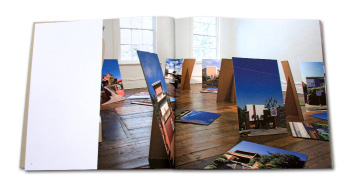
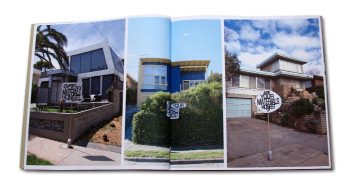
Es erscheint eine Vorzugsausgabe Nr.1 -10 dieses Künstlerkatalogs mit einem DinA-1 Plakat aus der Reihe "How long can I hold this up", signiert und nummeriert zum Preis von 150 Euro / A limited artists' edition No.1-10 of the catalogue together with an A1-poster, signed and numbered, is published with the book for150 EUR
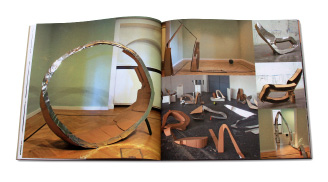
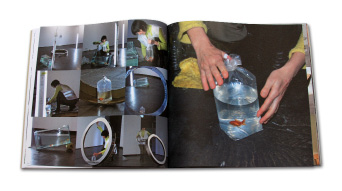

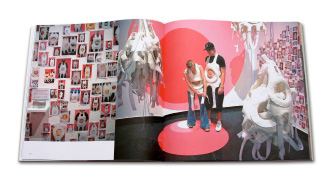

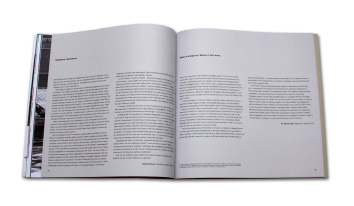
P r e s s e m i t t e i l u n g (deutsch – for ENGLISH please scroll down)
Wir freuen uns die Buchpräsentation "Simone Slee – Houses that are happy to help with at least one of the possible problems of art" zur gleichnamigen Ausstellung im Atelierfrankfurt anzukündigen.
Sculpture. Questions.
Simone Slee fährt mit dem Auto durch ihre Nachbarschaft, hält vor bestimmten Häusern, stellt ein Schild mit der Aufschrift "Are your materials honest?" auf und fotografiert beides zusammen. Niemand sieht sie. Die Straßen sind leer und die Bewohner der Häuser zeigen sich nicht oder sind abwesend.
Die fotografierten Häuser in einem Melbourner "Suburb" stehen monolithisch wie Skulpturen an der Straße oder in der Landschaft. Die kleinen Schilder stehen selbstgebastelt davor und stellen schüchtern, aber auch selbstbewusst ihre Frage, so wie ein Kind die Erwachsenen fragt: "Mama, woher kommen die Wolken?". Die Schilder stehen stabil in einer mit Sand gefüllten Milchflasche, wie sie morgens der Milchmann in die Einfahrt stellt. Diese Skulptur gehört in eine Reihe von Arbeiten, die durch die "Fish helps a sculpture"-Skulptur in Frankfurt in
der Galerie Wildwechsel eingeleitet wurde. Hier wurde ein labbriger mit Alufolie beklebter Pappkreis durch einen mit Wasser gefüllten Beutel, in dem ein Fisch schwamm, aufrecht gehalten. Der Fisch wurde immer wieder in ein Aquarium gegeben, dann ist die Skulptur umgekippt. Eine weitere Serie ist "How long can I hold this up?", wo wir die Künstlerin in Natur und Stadträumen sehen, wie sie ein Pappschild mit der Aufschrift "How long can I hold this up" hochhält.
Are your materials honest? Die Frage ist einfach gestellt, aber schwer zu beantworten. Als Kunststudenten haben wir uns immer gefragt, ob wir die Materialien auch richtig verwenden. Es gab ungeschriebene Gesetze, dass Malerei entweder ein Acrylbild oder besser noch ein Ölbild zu sein hatte oder mit Eitempera gemalt werden musste, jedenfalls irgendwie materialgerecht. Das kommt vielleicht von dieser "Form follows Function"-Idee der Bauhauserziehung, die nach dem Krieg an Design- und Kunstschulen eine große Rolle gespielt hat. Simone Slees Arbeiten scheinen jedoch frei zu sein von diesen Überlegungen. Die Künstlerin klebt Alufolie auf Pappe, stabilisiert das mit Fischen und startet ein imaginäres Gespräch zwischen Häusern, Skulpturen und Menschen, wie es Ad Reinhard 1946 eingeleitet hat, als er das Bild den Betrachter fragen ließ "HAHAHA What Do You Represent?" In den 40er Jahren des letzten Jahrhunderts war diese Frage bei Ad Reinhard ein "thought bubble" in einem amerikanischen Magazin, bei Simone Slee wird aus der Gedanken-Blase eine Skulptur in der australischen Vorstadt.
Elmgreen und Dragset haben bei den Skulpturprojekten in Münster 2007 ein Theaterstück mit verschiedenen Figuren aufgeführt, wo unter anderem eine Skulptur von Alberto Giacometti, der Walking Man, auf eine Skulptur von Barbara Hepworth und das Rabbit von Jeff Koons trifft. Eine richtige Konversation will aber nicht aufkommen, weil sich jede Skulptur für die beste hält. Die Aufführung fand im Rahmen einer Großausstellung in den städtischen Bühnen statt, also in einem geschützten Raum. Simone Slee aber kann nicht darauf hoffen, ein ihr zugeneigtes Publikum in den Suburbs von Melbourne zu finden. Sie fotografiert die Situation und baut daraus eine neue Skulptur. Das Foto wird mit einem Ink-Jet-Drucker ausgedruckt und auf Pappe aufgezogen. Ein Pappsteg auf der Rückseite schützt es vor dem Umkippen. In Frankfurt, wo ich lebe, sieht man an sehr vielen Häusern Transparente mit der Aufschrift "Zu vermieten" oder "Zu verkaufen" und es ist erfrischend vor einem Haus ein Schild mit einer komischen Frage zu sehen, die nichts mit Geld und Gewinnmaximierung zu tun hat.
Simone Slees Arbeiten changieren zwischen Appropriation Art, Skulptur und Performance. Die Künstlerin selbst fand eine Verbindung zu Douglas Hueblers Foto einer anonymen Menschenansammlung von 1977, mit der Bildunterschrift "Zumindest eine Person, die sich freuen könnte Teil eines Kunstwerks geworden zu sein". Slee kehrt die Beziehung zwischen Werk und Betrachter einfach um, indem sie den Zuschauer in die Arbeit miteinbindet. Im Fall von "Are Your Materials honest?" lässt die Vereinnahmung des Begriffs der Ehrlichkeit im Zusammenhang mit lebloser Materie, beispielsweise den Häusern, menschliche Eigenschaften angedeihen. Auf witzige Weise wird hier etwas Lebloses plötzlich belebt.
Semiotik, Werbung und Kunst fusionien in einer kleinen Sprechblase. "Are your materials honest" ähnlich wie Bruno Latours "Mixing Humans and Nonhumans Together"1 zeigt die Komplexität sozialer Wechselwirkungen am Beispiel eines einfachen Hauses auf, um zu veranschaulichen, dass es ein "hochmoralischer, ausgesprochen sozialer Akteur ist, der reiflich Überlegung verdient hat". Wer weiß schon, ob Häuser sich nicht wirklich unterhalten können und ob nicht Fische gerne die Skulpturen von Simone Slee stützen.
Andreas Exner, Frankfurt am Main, 2010
1 'Mixing Humans and Nonhumans Together: The Sociology of a Door-Closer', Author(s): Jim Johnson. Source: Social Problems, Vol. 35, No. 3, Special Issue: The Sociology of Science and Technology (June 1988), pp. 298-310.
Published by: University of California Press on behalf of the Society for the Study of Social Problems.
Es erscheint eine Vorzugsausgabe Nr.1 -10 dieses Künstlerkatalogs mit einem DinA-1 Plakat aus der Reihe "How long can I hold this up", signiert und nummeriert zum Preis von 150 Euro.
//////////////////////////////////////////////////////////////////////////////////////////////////////////////////////
P r e s s R e l e a s e
With great pleasure we announce the exhibition and book launch of 'Simone Slee – Houses that are happy to help with at least one of the possible problems of art' at Atelierfrankfurt.
Sculpture. Questions.
Simone Slee drives through her neighborhood, stops in front of particular houses, puts up a sign with the inscription 'Are Your Materials Honest?' and takes a photograph of the scene. Nobody sees her. The streets are empty and the houses' inhabitants don't show or are absent.
The houses in a Melbourne suburb stand monolithic like sculptures by the side of the road or in the middle of a landscape. Slee's small selfmade signs stand in front, asking shyly, but also confidently the question, just like a child asks an adult: 'Where do clouds come from?' In milk bottles filled with sand, the signs stand solidly; simple everyday bottles just like the ones the milkman brings to the door in the mornings. This sculpture belongs to a series of works, begun in 2006 with the installation titled Help a Sculpture at gallery Wildwechsel in Frankfurt. Here a wobbly cardboard circle, covered with aluminum foil, was kept upright by means of a plastic bag filled with water, inside of which a fish was swimming. Every now and then, when the fish was put back into an aquarium, the circle fell over. In another series of works from 2008, Slee again confronts the spectator with a simple question and we behold the artist amidst nature or in cityscapes holding up a sign with the inscription 'How long can I hold this up?'. Slee's multi-layered work bears references to some of the great contemporary oeuvres of artists explicitly working with image and text, namely the Truisms of Jenny Holzer, Lawrence Weiner's Statements or even Ed Ruscha's We Played House for 3 Years. Yet, rather than pointing an aphoristic finger, Slee highlights the discursive process by posing outright questions.
Are your materials honest? The question is quickly asked, but difficult to answer. When at art academy we always asked ourselves whether materials are being used in the proper way. There were unwritten laws that a proper painting had to be done either in acrylics, or even better, in oil on canvas, at the very least, a painting had to be painted in tempera; in any case it had to be executed 'true to the material'/'materialgerecht' somehow. This might still have something to do with the Bauhaus idea of 'form follows function' propagated at art and design schools since the 1920s. The work of Slee, on the other hand, appears free of these deliberations: The artist sticks aluminum foil onto cardboard, balances this with a bag of fish and begins an imaginary dialogue between houses, sculptures and the spectator; much like Ad Reinhardt has done in a cartoon, when he let the picture ask of the spectator 'Hahaha, what do YOU represent?' (1946). In Reinhardt's work this question took the form of a thought bubble in an American magazine; more than sixty years later in Slee's work the thought bubble becomes a performative sculpture in the Australian suburbs.
At the exhibition Sculpture Projects – Muenster, Elmgreen and Dragset showed Drama Queens, a play staged with several characters, where among others a sculpture by Alberto Giacometti, Walking Man, encounters a sculpture by Barbara Hepworth as well as Jeff Koons' Rabbit. A real conversation somehow isn't happening, as each sculpture is talking about being better than the rest. The play was staged as part of the big survey show at the local theatre, in a safe haven so to speak. Slee, however, can't hope to find a favourable audience in the suburbs. Instead she photographs the entire scene and creates a new sculpture from it. The photograph is printed poster-size with an ink-jet printer and mounted onto cardboard, with a flap on the back keeping it upright.
In Frankfurt, where I live and work, on many houses one can see 'For Rent' or 'For Sale' signs and it is refreshing to see a sign asking an odd question – one that has nothing to do with fiscal transactions or financial gain – in front of a house for a change.
Oscillating with Duchampian irony between Appropriation Art, sculpture and performance, Slee's sculpture by her own account found a connection with Douglas Huebler's photographs of anonymous crowds where, in 1977, Huebler wrote 'At least one person who might feel pleased to have been made the subject of art'. Slee inverts the relation between work and spectator, integrating the spectator in the production of the work itself. In the case of 'Are Your Materials Honest?' the misappropriation of honesty to the materials itself grants an agency or a human character to materials as well as to the form the materials take, i.e. the house. In a tongue-in-cheek way, something inanimate suddenly becomes animated.
Describing the fusion of semiotics, advertisement and art in one small speech-bubble Slee's 'Are Your Materials Honest?' much like Bruno Latour in 'Mixing Humans and Nonhumans Together'1 addresses the complexity of social interaction by means of choosing a humble house to illustrate that it is a 'highly moral, highly social actor that deserves careful consideration'. Who knows whether houses might not be able to have conversations and whether fish don't enjoy holding up sculptures?
Andreas Exner, Frankfurt am Main, 2010
1 'Mixing Humans and Nonhumans Together: The Sociology of a Door-Closer', Author(s): Jim Johnson. Source: Social Problems, Vol. 35, No. 3, Special Issue: The Sociology of Science and Technology (June 1988), pp. 298
A limited artists' edition No.1-10 of the catalogue together with an A1-poster, signed and numbered, is published with the book for150 EUR
[bestellungen
bitte an / all orders please directly at >>> hier
